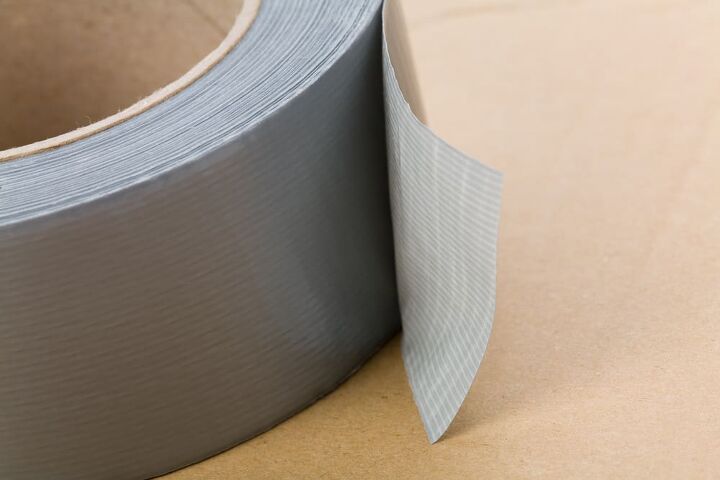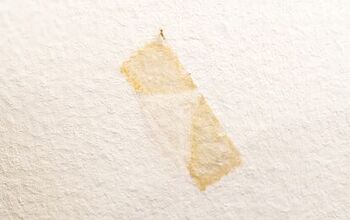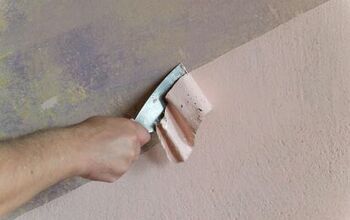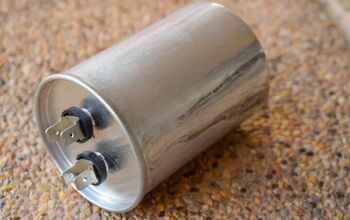How To Remove Duct Tape Residue (8 Ways To Do It!)

Duct tape may arguably be the most versatile tool around. There’s a good chance that you will find it in most homes and toolboxes across the world because of said versatility and affordability. Moreover, duct tape can stick in a similar fashion to glue for quality adhesion.
When it comes time to remove that duct tape, however, it can be a different story. Though it is no easy task, removing duct tape residue can be scraped off by using rubbing alcohol, warm water and soap, a lubricant, or even a hairdryer.
Let’s dive into the different methods and how to tackle the task.
Do You Need a Maid Service?
Get free, zero-commitment quotes from pro contractors near you.

Steps to Remove Duct Tape Residue
Method 1: Scrape it Off
The most relied upon method for duct tape residue that is both minimal and less than stubborn is to simply scrape it off. You can use a putty knife in most cases, though a butter knife will work if you are in a pinch or don’t feel like finding the putty knife.
Start at one end of the adhesive area and move slowly across. Use small scrapes, staying as consistent and repetitive as you can. Make sure to keep the blade as close to parallel to the surface as you can to avoid creating gauges. Should you be working on vinyl and wood, exercise extra caution because those two surfaces can be quite easily damaged.
Method 2: Use Rubbing Alcohol
Rubbing alcohol is a versatile cleaning agent that should be kept in the home if at all possible. If you’ve tried scraping the duct tape adhesive to little impact, try dissolving it away using rubbing alcohol. Keep in mind that rubbing alcohol is not suitable for painted surfaces and can start to pull up and chip away at that painted finish.
- Patch test. The best thing to do with rubbing alcohol is patch test it. You never know what reaction it will have with a given surface, so by patch testing it, you can see if there is any potential for damage and will avoid a nasty surprise.
- Dab on. Using a rag that has been soaked in isopropyl alcohol, dab over a small area and then cover the residue entirely. Start by working in small sections first, allowing the alcohol to evaporate.
- Wipe away. When you’ve dabbed the alcohol over the adhesive area and allowed it time to dry, now comes the time to wipe. In most cases, the adhesive should simply wipe away; if it doesn’t, you may need to apply again.
Method 3: Warm Water
More often than not, a little bit of warm water can remove that duct tape residue from softer or more fragile surfaces. If there is duct tape residue on vinyl, glass, and linoleum (high-gloss finishes), using warm water might be the best option.
The heat of the water softens the glue in the adhesive and the viscosity helps to push it away. Use a microfiber cloth or sponge to scrub, using back-and-forth strokes. If that doesn’t do the trick, you can add a couple of drops of dishwashing soap to help further break down that glue. Give it a 15-20 minute soak and then wipe it dry.
Method 4: Using Lubrication
As you may have noticed by now, the goal is to dissolve the glue adhesive on the underside of the duct tape. While there are a variety of ways to do so, it is this step that is the most important in removing duct tape residue.
Lubrication – generally something like WD-40 – can make for a highly effective solution against adhesives. Even better, lubricants are great for gentler surfaces like vinyl, linoleum, glass, and even finished wood, removing the chances of doing damage.
- Protect yourself. There are chemicals within lubricants like WD-40 that can potentially irritate the skin. Wear gloves while using it to prevent against that skin irritation.
- Spray on. After properly protecting yourself, spray the WD-40 (or whatever lubricant that you choose) over the entirety of the adhesive surface. After a few seconds, use your gloved finger to smooth the residue away.
- Wash with soap and water. Should this prove to be an effective method for removing the duct tape residue, simply wash away any of the remaining oil using water and soap. It is important that you not leave the oil from these lubricants on unfinished wood as it can sink into the pores permanently.
Method 5: Use a Hairdryer
An effective way to remove residue leftover from duct tape is by heating it up. Hot air weakens the duct tape’s adhesion, making it easier to get off of flat-painted woods and unfinished surfaces where you wouldn’t want to use oils or water.
Using heat may be the safest method overall, though it can take a little longer. Since heating doesn’t use liquids that could potentially penetrate porous surfaces, there is no risk of damage or discoloration.
- Put the hairdryer on high. Start by cranking your hairdryer up to its highest setting. It is important that you keep the hairdryer a few inches away from the surface.
- Scrape as you go. With the glue starting to peel away, use a putting knife to scrape up the now loosened residue. Work in small sections and blast it with hot air as you go.
This method should be effective at removing just about any duct tape residue, keeping even delicate surfaces protected from the damage that oils can cause.
Method 6: Use Cooking Oil
Your method for removing duct tape residue can depend entirely on what you have at hand. Ideally, rubbing alcohol or a hairdryer would be the most effective method, but what do you do if neither of those are near?
In a pinch, cooking oil can be effectively used to remove duct tape adhesive. Just be careful to not oversaturate the area as it can be difficult to clean the oil.
- Dab with oil. Dab a paper towel into the cooking oil, ensuring proper saturation.
- Cover the spot. Take your paper towel and cover the area with the residue. Give it a few minutes, allowing the oils to break down the adhesive.
- Scrape away. Remove the paper towel after a couple of minutes, scraping the adhesive away. If this works to your satisfaction, make sure to use soap and water to get rid of the excess oil so that it doesn’t get down into the surface of the material that you are cleaning.
Other oily products. If cooking oil isn’t available, you can use other oily products in a pinch. Peanut butter, mayonnaise, and baby oil are all fine for this purpose. Just be careful around absorbent materials like clothing and carpeting as the oil can stain it.
Method 7: Commercial Cleaners
When all else fails, turning to a commercial cleaner is rarely a bad move. Granted, there are certain chemicals that some may not be comfortable with, but they generally do an effective job of removing tough spots, stains, and adhesives.
Best of all, these cleaners are mostly available at general stores as well as hardware stores. There are even brands specifically designed to get rid of duct tape residue. Just follow the directions and you should be able to remove those tough spots.
Method 8: Pressure Washers
This is a somewhat limited option but can still be effective. You should only use a pressure washer for concrete, brick and clean rock surfaces. Doing so indoors can also be tricky, so if it has to be done, take out the furniture in the room to avoid getting it wet.
Use the pressure washer in concentrated blasts. Turn it on and off quickly while directly aiming it at the residue; the pressure from the water should be enough to remove even the toughest of spots. This should be treated as a very last-ditch effort.
Do You Need a Maid Service?
Get free, zero-commitment quotes from pro contractors near you.

How Do You Remove Duct Tape from Cloth?
From time to time, there may be a situation where the duct tape adhesive gets stuck to cloth or even clothing. There are a few quick methods that you may want to try. It requires a little more of a delicate touch but can be effective all the same.
- Remove the tape slowly. In some instances, all it takes to avoid residue is to remove the tape slowly. If you’re careful and a little lucky, you might be able to pull the duct tape free without having to worry about any residue.
- Dull kitchen knife. Should there be any leftover residue on the cloth, use a dulled kitchen knife to gently scrape them away. Because of the pliability of the cloth, it can be a difficult task to scrape away, so try this with great caution.
- Waterless hand cleaner. Spray a little waterless hand cleaner directly onto the residue, allowing a few minutes to break down the glue. Scrub gently using a brush or cloth to bring up chunks of the residue as you go.
- Apply pre-wash. Try applying some pre-wash stain remover on the impacted area before washing with regular detergent. The detergents should work to break down the residue, making it easier to clean.

Ryan Womeldorf has more than a decade of experience writing. He loves to blog about construction, plumbing, and other home topics. Ryan also loves hockey and a lifelong Buffalo sports fan.
More by Ryan Womeldorf



























